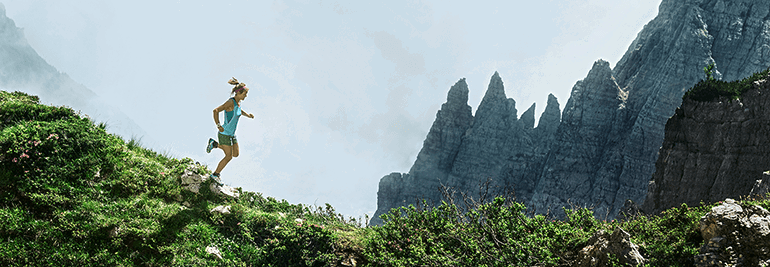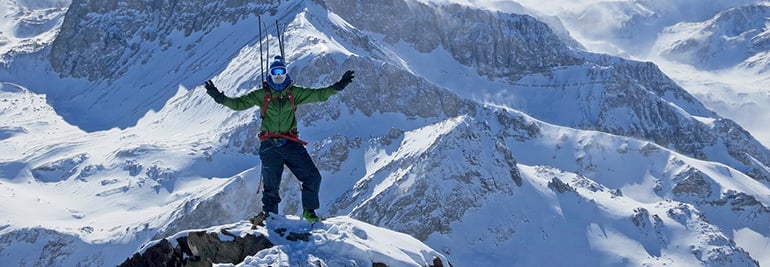

Suunto Blog

Dogsledding and diving in Greenland
It was a unique coming together of western explorers, locals and traditional hunter-fishermen. Four members of the Under the Pole expedition team, five young Inuit from the Uummannaq Children’s Home and two accompanying teachers were guided by Inuit hunter-fishermen on a 600 km dogsled adventure beyond Greenland's northern most territories.
First ice camp. © Lucas Santucci/Under the Pole
They learned how to manage a dogsled pack, how to go fishing on the ice to catch a feed for the pack, how to create a warm tent with reindeer skins and even a Greenlandic card game or two. The team, in return, guided the Inuit on their first ever dives beneath the ice.
Ghislain Bardout guiding teenager Nukaaraq under a glass ceiling. © Lucas Santucci/Under the Pole
Poor weather and a lack of snow this winter, however, nearly scuttled this last stage of the expedition. Exposed surface ice is abrasive to the dogs’ legs. Too little snow also means a lack of an easy water source. Fortunately conditions improved and the party set off north into the magical landscape between mountains and ocean.
They traveled by dogsled for eight days, sleeping in hunting cabins or in tents on the ice, learning about traditional Inuit ways.
12-year-old Miannguac sitting by a fishing hole to catch dinner for the dogs. © Lucas Santucci/Under the Pole
Whenever possible, the team encouraged the hunters and young people to dive.
“I was really impressed by their ability to adapt to the situation,” says Ghislain Bardout. “The way they moved under the sea ice despite the fact some of them can barely swim.
“After several dives, the most adventurous moved 10 m away from the hole and enjoyed observing the sea bed, fish and ice ceiling.
“Our objective was achieved; the young people became explorers of their own environment.”
All the young sub ice explorers and divers received certificates. © Lucas Santucci/Under the Pole
Main photo: © Lucas Santucci/Under the Pole

Big ambitions for 'Caveman' Conrad
'Caveman Conrad Stoltz is expecting to set some important firsts in 2015.
In the next month the four-time winner of the XTERRA World Championships and Olympic triathlete will become a father for the first time.
It means he will be racing less in 2015. But does that mean he’ll lose his fiercely competitive edge? Hell no, he says. In fact, this year he expects to gain an edge.
Conrad says 2014 was the toughest year of his sporting career. © Lighttrapper Photography
Having a child means another first; he’ll be staying put in South Africa for his first winter – anywhere – in 23 years. He’s been following a summer racing circuit since 1992, racing in the US and Europe over summer, then returning home to South Africa for its summer. “It’s been one long, extended summer,” he says.
Constant travelling to races around the world can be thrilling, he says, but also stressful and disruptive for high-level training.
“I think being based here is going to add a nice new dimension to my racing,” he says. “I will be fresher and better prepared because I’ll have my regular massage and my regular training venues.”
Caveman hopes staying based this year will improve his performance. © zooom.at/Markus Berger
He hopes this year is better than 2014, which he describes as the most challenging year of his entire sports career. Flat tires in races, sickness, falling down a flight of stairs before a race, injuries – lots of annoying little mishaps plagued his 2014.
“Being a professional athlete is such a roller coaster ride,” he says. “The highs are really, really high and the lows and really, really low.
“You need a special personality to cope with that.”
You have to have strong character to be a professional athlete, Conrad says. © zooom.at/Markus Berger
This year, however, will be different. Conrad has a quiet ambition for 2015; four and four. He’s won the XTERRA World Championships four times and the ITU Cross Triathlon World Championships three times. He'd be pleased to make it an even four and four.
“This year the Cross Tri champs are being held in Sardinia,” he says. “I’ve been looking at the maps and it seems the race suits me quite well.”
Off the race circuit, Conrad is also working on one business project he says will revolutionize the way sport coaching is conducted online and on another project running events specifically catered to kids.
This year will also be the last year he will race professionally, Conrad has announced. Becoming a father of a baby girl, desiring more family time, writing an autobiography, riding his motorcycle more often all mean it's time for the 41-year-old to ease up on the gas pedal. Will he continue training and pushing himself after professional retirement? You bet it. But just for fun.
This year he aims to make it four and four. © zooom.at/Markus Berger

Emelie Forsberg wins first trail run of season
Transvulcania was her first trail running race of the season and only one week after her last ski mountaineering race.
Before the gun fired, she wasn’t even sure if she’d finish the 87 km, 8,500 vertical meter race across the volcanoes of La Palma, Canary Islands. But from the start to the finish, she had the lead, giving no quarter to her rivals. Emelie won the race in 2013 and again this time.
Read more about Emelie Forsberg here.
“I took this race as a first approach to the trail running season after a long winter, and couldn’t have imagined this result,” she says. “As always, running Transvulcania is magic, with all the ambiance and the people cheering you during the race.”
A great performance for her first race of the trail running season. © Selu Vega-Transvulcania
The race began in the dawn light at the Tazacorte Lighthouse from where runners must climb an iconic lantern lit path leading to Los Canarios village. Emelie severely injured her hand in this section during last year’s race. She began cautiously, but this gave way to confidence, and she decided to seize the lead.
It was a good call as it gave her time to take it easy through the section from Pico del la Cruz to Roque de los Muchachos where many runners suffer from high temperatures.
“I haven’t had much training on high temperatures, and I was just skiing last week, so I knew the climb to Roque de los Muchachos would be the worst part,” Emelie says. “Fortunately my team told me I had a good advantage over the second girl so I was able to relax a bit and not get dehydrated.”
The rest of the race went smoothly and she crossed the finish line in Los Llanos de Adriane with a time of 8h 34m.
Suunto ambassador Ryan Sandes was also taking part, but had to pull out of the race due to severe cramping. “I am disappointed but this is part of being an athlete,” he posted online.

BENEFITS FOR USING TRAININGPEAKS WITH YOUR SUUNTO
Suunto became compatible with TrainingPeaks this spring. We got in touch with Canadian ultra runner Rodney Buike to learn more about the service.
Rodney Buike started his athletic career as an alpine ski racer and a mountain biker but has since evolved into an endurance athlete covering longer and longer distances. First he competed in duathlons and triathlons, but has recently started to run ultras, too.
Buike has been using TrainingPeaks as his main tracking application since 2011.
“I initially started with the free version of TrainingPeaks but soon switched to TrainingPeaks Premium for some of the added capabilities,” says Buike.
“For me the best feature is the Performance Management Chart. It gives me a real ability to manage my fitness and fatigue levels over the course of my racing season.”
TrainingPeaks’ Performance Management Chart (PMC) tracks chronic training load (CTL based on activities older than 15 days) and acute training load (ATL based on the last 14 days of activity). These numbers are based on the athlete’s thresholds which allows TrainingPeaks to calculate the intensity (IF) and Training Stress Score (TSS). This is then used to calculate Training Stress Balance (TSB). All this data can be used to monitor progress and ensure a smooth steady build up and then taper to main race or races.
Here’s Buike’s own PMC starting with the beginning of training for his first 50K race.
Rodney Buike’s 180-day Performance Management Chart
“The first vertical red line is the peak of training with the longest run before tapering began for the race (the next vertical red line). Then you can see the recovery period and the final vertical red line indicating when training began again,” Buike explains.
“There are a few important things you can see in this graph: First off you can see a long slow steady build with the gradual increase in the CTL (the blue line). There are smaller spikes along the line, which individually identify the key long runs followed by short recovery periods – but an overall steady climb. The TSB (orange line) moves into the positive as I recover and taper for the race while the ATL drops as training load is decreased.”
Over the course of time the Performance Management Chart can help you plan your taper and recovery to ensure you are doing just enough to maintain fitness while recovering properly to ensure your best performance on race day.
SET YOUR ZONES FIRST
While this all sounds very complex there are a few very basic things that all athletes can take advantage of immediately.
“The first thing I recommend is to set your zones. If you are using HR based training you can set different zones for all activities. For specific activities you can also define additional zones. I highly suggest runners to set their pace zones, which can be done using the results of a recent 10KM running race. Cyclists, who have a power meter, can input their functional threshold power (FTP) and use that to build power zones.”
In addition to the Performance Management Chart, Buike highlights the premium version’s advanced charts that you can use to drill deeper into the data (power analysis, scatter graphs, etc.). He also finds the planning tools very useful.
“With the premium version you have the ability to plan out your upcoming week, month or longer and have that sync with your calendar in Outlook, Gmail, Apple iCalendar or any calendar tool that supports ICS files. When you upload activities they will automatically populate the related activity in your TrainingPeaks calendar,” says Buike.
So how does your own calendar look for the coming weeks?
“I have decided to move into the ultra running world and completed my first 50 km and 80 km races recently. In May I have a 130km race coming up.”

Top performances at Suunto Vertical Blue 2015
The big news from Suunto Vertical Blue 2015 isn’t who became overall winner.
With multiple record holder Will Trubridge’s main rival Russian Alex Molchanov out of this year’s competition, Will won the top spot unchallenged.
But that doesn’t mean he didn’t learn a thing or two. On day three he had a run in with the dazed and confused, absent-minded state that sometimes bewilders freedivers when they’re in the depths.
Will Trubridge took home gold. ©Daan Verhoeven
Once they’ve hit maximum depth and to prove they’ve reached it, freedivers must collect a tag from the bottom plate at the end of a line that hangs from the surface. Sounds simple enough, right?
Wrong. After diving down vertically for minutes on a single breath the body is desperate for oxygen, sometimes resulting in what’s called nitrogen narcosis which can cause confusion, even hallucinations.
It's not uncommon for freedivers to experience hallucinations. ©Daan Verhoeven
Freedivers have to rely on their training and on visualization techniques to stay calm and to swim to the surface, one patient stroke at a time.
“I had some difficulty at the bottom plate attaching the tag to the velcro on my leg and ended up stuffing it in the neck of my wetsuit instead,” Will says. “I must have been pretty narced (experiencing nitrogen narcosis), which increased on the way up — meaning I didn’t find the complete relaxation I was looking for.
“It was still a clean dive, and fairly quick for that FIM depth.”
Will Trubridge is competing in two more competitons in the next two months. ©zooom.at/ Samo Vidic
The next day, however, Will returned to perfect form and achieved a constant weight dive to 116 m in 3 m 17 s.
“I'm happy with how I performed, finishing with maximum depths of 94m CNF, 115m FIM and 116/120 m CWT.”
Sayuri Kinoshita from Japan was the overall winner of the women. She broke Japan’s national FIM record four times and the CNF national record once.
The bigger splash to come out of this year’s event is that 29 national records were broken by 12 of the 23 freedivers taking part. Colombian Sofia Gómez Uribe earned national records in the event’s three sports; FIM, CNF, CWT. Five other athletes broke national records in two sports.
Tomoka Fukada broke Japan's national FIM record. ©Daan Verhoeven
For the men, Ryuzo Shinomiya of Japan came in second, followed by Alejandro Lemus of Mexico. For the women, Tomoka Fukada from Japan came second and Katerina Linczenyovia of Slovakia came third.
“Above all, this year’s contest has been a lot of fun,” Will Trubridge says. “We've had some spectacular conditions in the Blue Hole as well as rain, wind and cold and I've been able to perform in both, so that’s good to take away from this event and into the next two competitions in Honduras (Caribbean Cup) and Colombia (Nirvana).”
Another great year for Suunto Vertical Blue at Deans Blue Hole in the Bahamas. ©zooom.at/ Samo Vidic
Main photo: ©Daan Verhoeven

THE TRASLIN STREAK: 104 MONTHS OF SKIING AND STILL GOING
Canadian backcountry skiers Andy and Mike Traslin love skiing – whatever the conditions. As a result they have skied every single month for 104 months! We caught up with Andy to talk about their never-ending ski season.
How did your endless ski season get started?Our original goal was to try to ski for 12 months in a row, one consecutive year. After that it just became part of my life. When we got to 85 I started thinking that it would be a good goal, a cool milestone, to hit 100.
How has it been possible to accomplish this? Have you travelled a lot?What makes this possible is where we live in the Southwestern part of British Columbia. Here a deep snowpack typically tends to stick all year round in the high alpine. From our base it is two hours to Whistler and two hours to Mt. Baker.
I really enjoy traveling and seeing new areas. BC has endless terrain for backcountry skiing.
My favorite spot is Mt. Baker in Washington, USA. Mt Baker is a volcano that rises to 3,286 meters (10,770 feet), offers over 2,000 meters (7000 feet) of descent and glaciated terrain that has snow all year round. There’s everything from short early winter powder laps to epic steep ski descents on the North Face in spring and summer.
Andy Traslin enjoying the endless winter.
Has there been any nearly missed months along the way?As in any sport injuries happen. Mike had a knee injury. I pulled my back. But we still managed to get out there. Lately we have made sure to go out at the beginning of the month to leave more time in case injuries or unforeseen circumstances.
Have you noticed any significant changes in the snow cover during these years?The past two years has been significantly less snowfall. Especially this year has been one of the worst seasons I can remember. Hopefully this is not a sign of things to come. I have grown up in this area and there were seasons like this in the 80s.
Have you skied together every month?We ski together most of the summer months. But in the main part of the season it's good to get out and ski with other people. I also like to ski solo once in a while as well.
How would you describe yourself as a skier and mountaineer?First and foremost I'm a skier but I also enjoy mountaineering. But when I discovered that I can climb up a mountain and ski back down I knew that was for me.
Andy Traslin hiking up last summer.
What motivates you to get out there and ski so much?I just really like to be outside, especially in the mountains skiing. That is my passion. Turns all year have enabled me to be out there pushing myself to the limits and skiing all the time in all types of conditions.
I have a real passion for steep ski mountaineering. So sometimes you have take risks to reach your ultimate goal. The mountain has the last say. So you have to follow your intuition and rely on years of experience in the mountains and know when to turn around.
The moments that really stick with me are when the sun, stability and people conditions line up perfectly. All the planning and hard work line up for that moment. That feeling of being alive and one with nature and flowing with gravity in a natural way.
Watch “95 ‘Till Infinity – Traslin’s Never Ending Shred”














































































